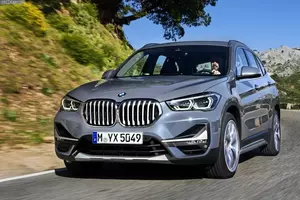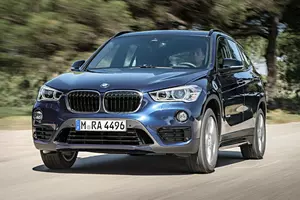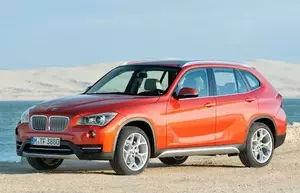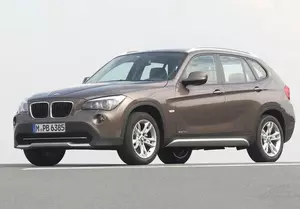


| Vehicle | Curb weight | Difference from world's smallest | Weight to power ratio | 0—60 mph acceleration ratio | Consumption ratio |
|---|---|---|---|---|---|
| 16d |
1480 kg / 3263 lbs |
1055 kg (2326 lbs) heavier | 13 kg to 1 hp | 136 kg/s (300 lbs/s) |
361 kg/L (796 lbs/L) |
| 25d |
1575 kg / 3473 lbs |
1150 kg (2536 lbs) heavier | 7 kg to 1 hp | 250 kg/s (551 lbs/s) |
321 kg/L (708 lbs/L) |
| 25i |
1580 kg / 3484 lbs |
1155 kg (2547 lbs) heavier | 7 kg to 1 hp | 255 kg/s (562 lbs/s) |
251 kg/L (553 lbs/L) |
| 18d |
1605 kg / 3539 lbs |
1180 kg (2602 lbs) heavier | 11 kg to 1 hp | 180 kg/s (397 lbs/s) |
341 kg/L (752 lbs/L) |
| 20d |
1615 kg / 3561 lbs |
1190 kg (2624 lbs) heavier | 9 kg to 1 hp | 218 kg/s (481 lbs/s) |
344 kg/L (759 lbs/L) |
| 18i |
1430 kg / 3153 lbs |
1005 kg (2216 lbs) heavier | 10 kg to 1 hp | 155 kg/s (342 lbs/s) |
265 kg/L (584 lbs/L) |
| 20i |
1570 kg / 3462 lbs |
1145 kg (2525 lbs) heavier | 8 kg to 1 hp | 224 kg/s (494 lbs/s) |
249 kg/L (549 lbs/L) |
| 25e |
1745 kg / 3848 lbs |
1320 kg (2911 lbs) heavier | 14 kg to 1 hp | 264 kg/s (582 lbs/s) | - |
| Vehicle | 16d |
|---|---|
| Curb weight |
1480 kg / 3263 lbs |
| Difference from world's smallest | 1055 kg (1055 lbs) heavier |
| Weight to power ratio | 13 kg to 1 hp |
| 0—60 mph acceleration ratio | 136 kg/s (300 lbs/s) |
| Consumption ratio |
361 kg/L (796 lbs/L) |
| Vehicle | 25d |
| Curb weight |
1575 kg / 3473 lbs |
| Difference from world's smallest | 1150 kg (1150 lbs) heavier |
| Weight to power ratio | 7 kg to 1 hp |
| 0—60 mph acceleration ratio | 250 kg/s (551 lbs/s) |
| Consumption ratio |
321 kg/L (708 lbs/L) |
| Vehicle | 25i |
| Curb weight |
1580 kg / 3484 lbs |
| Difference from world's smallest | 1155 kg (1155 lbs) heavier |
| Weight to power ratio | 7 kg to 1 hp |
| 0—60 mph acceleration ratio | 255 kg/s (562 lbs/s) |
| Consumption ratio |
251 kg/L (553 lbs/L) |
| Vehicle | 18d |
| Curb weight |
1605 kg / 3539 lbs |
| Difference from world's smallest | 1180 kg (1180 lbs) heavier |
| Weight to power ratio | 11 kg to 1 hp |
| 0—60 mph acceleration ratio | 180 kg/s (397 lbs/s) |
| Consumption ratio |
341 kg/L (752 lbs/L) |
| Vehicle | 20d |
| Curb weight |
1615 kg / 3561 lbs |
| Difference from world's smallest | 1190 kg (1190 lbs) heavier |
| Weight to power ratio | 9 kg to 1 hp |
| 0—60 mph acceleration ratio | 218 kg/s (481 lbs/s) |
| Consumption ratio |
344 kg/L (759 lbs/L) |
| Vehicle | 18i |
| Curb weight |
1430 kg / 3153 lbs |
| Difference from world's smallest | 1005 kg (1005 lbs) heavier |
| Weight to power ratio | 10 kg to 1 hp |
| 0—60 mph acceleration ratio | 155 kg/s (342 lbs/s) |
| Consumption ratio |
265 kg/L (584 lbs/L) |
| Vehicle | 20i |
| Curb weight |
1570 kg / 3462 lbs |
| Difference from world's smallest | 1145 kg (1145 lbs) heavier |
| Weight to power ratio | 8 kg to 1 hp |
| 0—60 mph acceleration ratio | 224 kg/s (494 lbs/s) |
| Consumption ratio |
249 kg/L (549 lbs/L) |
| Vehicle | 25e |
| Curb weight |
1745 kg / 3848 lbs |
| Difference from world's smallest | 1320 kg (1320 lbs) heavier |
| Weight to power ratio | 14 kg to 1 hp |
| 0—60 mph acceleration ratio | 264 kg/s (582 lbs/s) |
| Consumption ratio | - |

| Vehicle | Curb weight | Difference from world's smallest | Weight to power ratio | 0—60 mph acceleration ratio | Consumption ratio |
|---|---|---|---|---|---|
| 25i |
1580 kg / 3484 lbs |
1155 kg (2547 lbs) heavier | 7 kg to 1 hp | 251 kg/s (553 lbs/s) |
232 kg/L (512 lbs/L) |
| 25d |
1575 kg / 3473 lbs |
1150 kg (2536 lbs) heavier | 7 kg to 1 hp | 250 kg/s (551 lbs/s) |
315 kg/L (695 lbs/L) |
| 20d |
1615 kg / 3561 lbs |
1190 kg (2624 lbs) heavier | 9 kg to 1 hp | 218 kg/s (481 lbs/s) |
336 kg/L (741 lbs/L) |
| 18d |
1540 kg / 3396 lbs |
1115 kg (2459 lbs) heavier | 10 kg to 1 hp | 173 kg/s (381 lbs/s) |
335 kg/L (739 lbs/L) |
| 20i |
1570 kg / 3462 lbs |
1145 kg (2525 lbs) heavier | 8 kg to 1 hp | 209 kg/s (461 lbs/s) |
234 kg/L (516 lbs/L) |
| 16d |
1425 kg / 3142 lbs |
1000 kg (2205 lbs) heavier | 12 kg to 1 hp | 136 kg/s (300 lbs/s) |
365 kg/L (805 lbs/L) |
| 18i |
1420 kg / 3131 lbs |
995 kg (2194 lbs) heavier | 10 kg to 1 hp | 154 kg/s (340 lbs/s) |
245 kg/L (540 lbs/L) |
| Vehicle | 25i |
|---|---|
| Curb weight |
1580 kg / 3484 lbs |
| Difference from world's smallest | 1155 kg (1155 lbs) heavier |
| Weight to power ratio | 7 kg to 1 hp |
| 0—60 mph acceleration ratio | 251 kg/s (553 lbs/s) |
| Consumption ratio |
232 kg/L (512 lbs/L) |
| Vehicle | 25d |
| Curb weight |
1575 kg / 3473 lbs |
| Difference from world's smallest | 1150 kg (1150 lbs) heavier |
| Weight to power ratio | 7 kg to 1 hp |
| 0—60 mph acceleration ratio | 250 kg/s (551 lbs/s) |
| Consumption ratio |
315 kg/L (695 lbs/L) |
| Vehicle | 20d |
| Curb weight |
1615 kg / 3561 lbs |
| Difference from world's smallest | 1190 kg (1190 lbs) heavier |
| Weight to power ratio | 9 kg to 1 hp |
| 0—60 mph acceleration ratio | 218 kg/s (481 lbs/s) |
| Consumption ratio |
336 kg/L (741 lbs/L) |
| Vehicle | 18d |
| Curb weight |
1540 kg / 3396 lbs |
| Difference from world's smallest | 1115 kg (1115 lbs) heavier |
| Weight to power ratio | 10 kg to 1 hp |
| 0—60 mph acceleration ratio | 173 kg/s (381 lbs/s) |
| Consumption ratio |
335 kg/L (739 lbs/L) |
| Vehicle | 20i |
| Curb weight |
1570 kg / 3462 lbs |
| Difference from world's smallest | 1145 kg (1145 lbs) heavier |
| Weight to power ratio | 8 kg to 1 hp |
| 0—60 mph acceleration ratio | 209 kg/s (461 lbs/s) |
| Consumption ratio |
234 kg/L (516 lbs/L) |
| Vehicle | 16d |
| Curb weight |
1425 kg / 3142 lbs |
| Difference from world's smallest | 1000 kg (1000 lbs) heavier |
| Weight to power ratio | 12 kg to 1 hp |
| 0—60 mph acceleration ratio | 136 kg/s (300 lbs/s) |
| Consumption ratio |
365 kg/L (805 lbs/L) |
| Vehicle | 18i |
| Curb weight |
1420 kg / 3131 lbs |
| Difference from world's smallest | 995 kg (995 lbs) heavier |
| Weight to power ratio | 10 kg to 1 hp |
| 0—60 mph acceleration ratio | 154 kg/s (340 lbs/s) |
| Consumption ratio |
245 kg/L (540 lbs/L) |

| Vehicle | Curb weight | Difference from world's smallest | Weight to power ratio | 0—60 mph acceleration ratio | Consumption ratio |
|---|---|---|---|---|---|
| 20i |
1665 kg / 3671 lbs |
1240 kg (2734 lbs) heavier | 9 kg to 1 hp | 222 kg/s (490 lbs/s) |
235 kg/L (518 lbs/L) |
| 18i |
1530 kg / 3374 lbs |
1105 kg (2437 lbs) heavier | 10 kg to 1 hp | 155 kg/s (342 lbs/s) |
194 kg/L (428 lbs/L) |
| 28i |
1670 kg / 3682 lbs |
1245 kg (2745 lbs) heavier | 7 kg to 1 hp | 274 kg/s (604 lbs/s) |
232 kg/L (512 lbs/L) |
| 16d |
1570 kg / 3462 lbs |
1145 kg (2525 lbs) heavier | 14 kg to 1 hp | 147 kg/s (324 lbs/s) |
314 kg/L (692 lbs/L) |
| 18d |
1650 kg / 3638 lbs |
1225 kg (2701 lbs) heavier | 12 kg to 1 hp | 174 kg/s (384 lbs/s) |
306 kg/L (675 lbs/L) |
| 20d |
1575 kg / 3473 lbs |
1150 kg (2536 lbs) heavier | 9 kg to 1 hp | 216 kg/s (476 lbs/s) |
315 kg/L (695 lbs/L) |
| 25d |
1670 kg / 3682 lbs |
1245 kg (2745 lbs) heavier | 8 kg to 1 hp | 261 kg/s (576 lbs/s) |
304 kg/L (670 lbs/L) |
| Vehicle | 20i |
|---|---|
| Curb weight |
1665 kg / 3671 lbs |
| Difference from world's smallest | 1240 kg (1240 lbs) heavier |
| Weight to power ratio | 9 kg to 1 hp |
| 0—60 mph acceleration ratio | 222 kg/s (490 lbs/s) |
| Consumption ratio |
235 kg/L (518 lbs/L) |
| Vehicle | 18i |
| Curb weight |
1530 kg / 3374 lbs |
| Difference from world's smallest | 1105 kg (1105 lbs) heavier |
| Weight to power ratio | 10 kg to 1 hp |
| 0—60 mph acceleration ratio | 155 kg/s (342 lbs/s) |
| Consumption ratio |
194 kg/L (428 lbs/L) |
| Vehicle | 28i |
| Curb weight |
1670 kg / 3682 lbs |
| Difference from world's smallest | 1245 kg (1245 lbs) heavier |
| Weight to power ratio | 7 kg to 1 hp |
| 0—60 mph acceleration ratio | 274 kg/s (604 lbs/s) |
| Consumption ratio |
232 kg/L (512 lbs/L) |
| Vehicle | 16d |
| Curb weight |
1570 kg / 3462 lbs |
| Difference from world's smallest | 1145 kg (1145 lbs) heavier |
| Weight to power ratio | 14 kg to 1 hp |
| 0—60 mph acceleration ratio | 147 kg/s (324 lbs/s) |
| Consumption ratio |
314 kg/L (692 lbs/L) |
| Vehicle | 18d |
| Curb weight |
1650 kg / 3638 lbs |
| Difference from world's smallest | 1225 kg (1225 lbs) heavier |
| Weight to power ratio | 12 kg to 1 hp |
| 0—60 mph acceleration ratio | 174 kg/s (384 lbs/s) |
| Consumption ratio |
306 kg/L (675 lbs/L) |
| Vehicle | 20d |
| Curb weight |
1575 kg / 3473 lbs |
| Difference from world's smallest | 1150 kg (1150 lbs) heavier |
| Weight to power ratio | 9 kg to 1 hp |
| 0—60 mph acceleration ratio | 216 kg/s (476 lbs/s) |
| Consumption ratio |
315 kg/L (695 lbs/L) |
| Vehicle | 25d |
| Curb weight |
1670 kg / 3682 lbs |
| Difference from world's smallest | 1245 kg (1245 lbs) heavier |
| Weight to power ratio | 8 kg to 1 hp |
| 0—60 mph acceleration ratio | 261 kg/s (576 lbs/s) |
| Consumption ratio |
304 kg/L (670 lbs/L) |

| Vehicle | Curb weight | Difference from world's smallest | Weight to power ratio | 0—60 mph acceleration ratio | Consumption ratio |
|---|---|---|---|---|---|
| 20i |
1650 kg / 3638 lbs |
1225 kg (2701 lbs) heavier | 9 kg to 1 hp | 223 kg/s (492 lbs/s) |
214 kg/L (472 lbs/L) |
| 18i |
1505 kg / 3319 lbs |
1080 kg (2382 lbs) heavier | 10 kg to 1 hp | 164 kg/s (362 lbs/s) |
184 kg/L (406 lbs/L) |
| 25i |
1675 kg / 3693 lbs |
1250 kg (2756 lbs) heavier | 8 kg to 1 hp | 223 kg/s (492 lbs/s) |
180 kg/L (397 lbs/L) |
| 18d |
1615 kg / 3561 lbs |
1190 kg (2624 lbs) heavier | 11 kg to 1 hp | 168 kg/s (370 lbs/s) |
283 kg/L (624 lbs/L) |
| 28i |
1685 kg / 3715 lbs |
1260 kg (2778 lbs) heavier | 7 kg to 1 hp | 259 kg/s (571 lbs/s) |
179 kg/L (395 lbs/L) |
| 20d |
1650 kg / 3638 lbs |
1225 kg (2701 lbs) heavier | 9 kg to 1 hp | 206 kg/s (454 lbs/s) |
284 kg/L (626 lbs/L) |
| 23d |
1660 kg / 3660 lbs |
1235 kg (2723 lbs) heavier | 8 kg to 1 hp | 241 kg/s (531 lbs/s) |
277 kg/L (611 lbs/L) |
| Vehicle | 20i |
|---|---|
| Curb weight |
1650 kg / 3638 lbs |
| Difference from world's smallest | 1225 kg (1225 lbs) heavier |
| Weight to power ratio | 9 kg to 1 hp |
| 0—60 mph acceleration ratio | 223 kg/s (492 lbs/s) |
| Consumption ratio |
214 kg/L (472 lbs/L) |
| Vehicle | 18i |
| Curb weight |
1505 kg / 3319 lbs |
| Difference from world's smallest | 1080 kg (1080 lbs) heavier |
| Weight to power ratio | 10 kg to 1 hp |
| 0—60 mph acceleration ratio | 164 kg/s (362 lbs/s) |
| Consumption ratio |
184 kg/L (406 lbs/L) |
| Vehicle | 25i |
| Curb weight |
1675 kg / 3693 lbs |
| Difference from world's smallest | 1250 kg (1250 lbs) heavier |
| Weight to power ratio | 8 kg to 1 hp |
| 0—60 mph acceleration ratio | 223 kg/s (492 lbs/s) |
| Consumption ratio |
180 kg/L (397 lbs/L) |
| Vehicle | 18d |
| Curb weight |
1615 kg / 3561 lbs |
| Difference from world's smallest | 1190 kg (1190 lbs) heavier |
| Weight to power ratio | 11 kg to 1 hp |
| 0—60 mph acceleration ratio | 168 kg/s (370 lbs/s) |
| Consumption ratio |
283 kg/L (624 lbs/L) |
| Vehicle | 28i |
| Curb weight |
1685 kg / 3715 lbs |
| Difference from world's smallest | 1260 kg (1260 lbs) heavier |
| Weight to power ratio | 7 kg to 1 hp |
| 0—60 mph acceleration ratio | 259 kg/s (571 lbs/s) |
| Consumption ratio |
179 kg/L (395 lbs/L) |
| Vehicle | 20d |
| Curb weight |
1650 kg / 3638 lbs |
| Difference from world's smallest | 1225 kg (1225 lbs) heavier |
| Weight to power ratio | 9 kg to 1 hp |
| 0—60 mph acceleration ratio | 206 kg/s (454 lbs/s) |
| Consumption ratio |
284 kg/L (626 lbs/L) |
| Vehicle | 23d |
| Curb weight |
1660 kg / 3660 lbs |
| Difference from world's smallest | 1235 kg (1235 lbs) heavier |
| Weight to power ratio | 8 kg to 1 hp |
| 0—60 mph acceleration ratio | 241 kg/s (531 lbs/s) |
| Consumption ratio |
277 kg/L (611 lbs/L) |